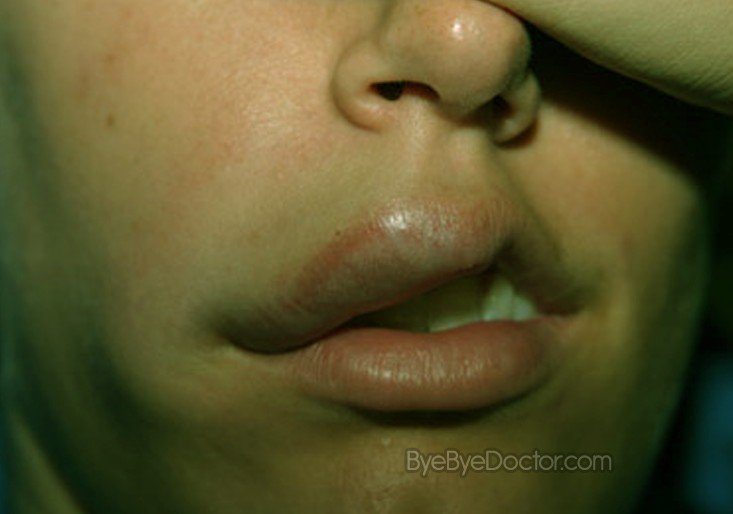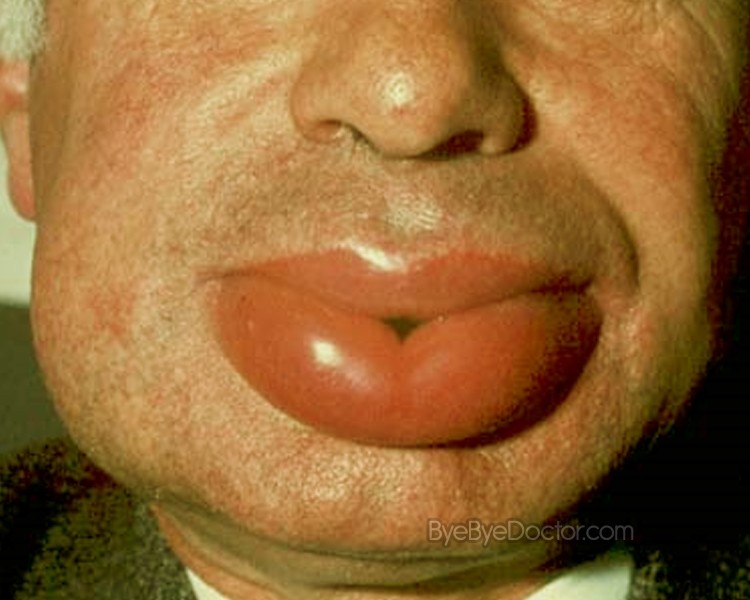What is Angioedema?
Angioedema is a medical condition involving the swelling of the tissue below the skin and/or mucous membranes, which are called the dermis (bottom layer of skin), the subcutaneous tissue (fat tissue), and submucosal tissue (structural tissue beneath mucous membranes).
Most cases of angioedema involve mild swelling, however when it occurs rapidly and causes a large amount of swelling, or occurs in the mouth, nose, or throat, it is often a medical emergency. When angioedema occurs in the mouth, nose, or throat, it can block an individual’s airway, leading to respiratory distress or inability to breath, and emergency medical attention is needed.
Angioedema Symptoms
There are several signs and symptoms of angioedema, as listed below:
- Swelling of the tissues underneath the skin.
- Itchiness, and possible pain, of the swollen areas.
- Slight tingling or numbness of swollen areas related to nerve compression.
- Hives (urticaria) may break out on swollen areas.
- Wheezing, gasping for breath, feeling of tightness in throat or inability to breath are signs of a medical emergency, and medical attention should be sought immediately.
Angioedema Causes
Angioedema is caused by leakage of fluid out of the bloodstream and into the surrounding tissues, causing them to be puffy and swollen. The exact cause of the leakage depends on the type of the disorder. There are two functional classification of angioedema, acquired and hereditary. Acquired angioedema is usually caused by an allergic reaction and hereditary angioedema is a genetic disorder.
Acquired angioedema (medically abbreviated AAE) is usually part of an allergic reaction. There may be a recent exposure to an allergen, but most often it is unknown why this condition occurs. AAE is also known to be an uncommon reaction to ACE inhibitor medications, drugs used to treat blood pressure and certain heart conditions. AAE usually affects the face, but may also affect the hands, and more rarely, other parts of the body.
AAE is an exaggerated form of the body’s natural allergic response. When an allergen is detected in the body, substances are released which attract white blood cells to the site. These substances also cause vasodilation, or an increase in the diameter the blood vessels and an increase in the permeability of the walls of the blood vessels. This permits white blood cells that are normally contained within the walls of the blood vessels to be able to leak into the tissue and fight the allergens, however it also allows plasma (the liquid portion of the blood) to leak into the tissues as well.
A normal allergic reaction involves swelling of the affected tissues for this reason, however in AAE, vasodilation occurs too rapidly or for too long, allowing too much plasma to leak into the tissues and creating a large amount of swelling. The swelling usually reaches a peak within 12-36 hours, and usually does not require hospitalization.
http://www.Symptoms-Causes-treatment.blogspot.com detect diseases at an early stage symptoms, and find out the causes and treatments best suited.
Hereditary angioedema (medically abbreviated as HAE) is a genetic condition and there are three classified types: type I HAE, type II HAE, and type III HAE. All types of hereditary angioedema are caused by dysfunctional genetic mutations, and they all cause a lack or deficiency of an important chemical in the body called ‘C1-inhibitor’. The main role of C1-inhibitor is to limit the allergic response created by the immune system. Without a sufficient amount of C1-inhibitor, allergic responses become exaggerated and can occur for no reason, thus causing the symptoms of HAE.
Hereditary angioedema can cause swelling anywhere in the body, and is not limited to the face and hands as acquired angioedema usually is. Many individuals with HAE also have recurrent episodes of swelling in the abdomen, causing pain, vomiting, and diarrhea, along with a generalized rash, that last for 1-5 days. Patients have these abdominal attacks may require hospitalization for treatment of these symptoms, rehydration, and pain relief. HAE causes these episodes of swelling also occur in other parts of the body, including the face, throat, neck, arms, legs, or genitals.
Angioedema Treatment
Treatment for angioedema attempts to stop the allergic reaction process of the body by blocking one of two chemicals involved in the allergic response, histamine and bradykinin.
AAE is treated with antihistamines, including some of the following medications:
- Benadryl (diphenhydramine) or Atarax (hydroxyzine) is given orally in most cases, but can be given by injection in more severe cases.
- Corticosteroids can be given in moderate to severe cases by injection, including hydrocortisone or Solu-Medrol (methylprednisolone).
- Epinephrine is given in emergency situations where breathing is impaired by swelling of the throat, neck, or mouth.
- Second-generation antihistamines may be given to prevent further AAE episodes, such as Zyrtec (certirizine), Allegra (fexofenadine), or Claritin (loratidine).
Treatments for HAE are less abundant, and most treatment focuses on maintaining a patent airway and relieving the symptoms. Because the allergic response caused by HAE involves bradykinin and not histamine, none of the treatments for AAE have any effect. Treatment for HAE involves hospitalization and there are a few medication options:
- Fresh, frozen plasma (a blood product) can be helpful in reducing symptoms.
- Berinert (C1-inhibitor infusion) can be given intravenously in severe cases.
- Kalbitor (escallantide) is a recently approved drug that decreases the production of bradykinin, reducing the allergic response.
- Nausea, vomiting, diarrhea, and pain are treated with various appropriate medications.
Angioedema Pictures



